Swagger
1.简介
RestFul API文档在线自动生成工具 => API文档与API定义同步更新
直接运行,可以在线测试API接口
2.在项目使用Swagger需要springfox
- swagger2
- ui
3.SpringBoot集成Swagger2
在pom.xml中导入依赖
1 2 3 4 5 6 | <!-- https://mvnrepository.com/artifact/io.springfox/springfox-swagger2 --><dependency> <groupId>io.springfox</groupId> <artifactId>springfox-swagger2</artifactId> <version>2.9.2</version></dependency> |
1 2 3 4 5 6 | <!-- https://mvnrepository.com/artifact/io.springfox/springfox-swagger-ui --><dependency> <groupId>io.springfox</groupId> <artifactId>springfox-swagger-ui</artifactId> <version>2.9.2</version></dependency> |
4.编写一个Hello工程
1 2 3 4 5 6 7 8 9 10 11 12 13 | package com.kuang.swagger.controller;import org.springframework.web.bind.annotation.RequestMapping;import org.springframework.web.bind.annotation.RestController;@RestControllerpublic class HelloController { @RequestMapping("/hello") public String hello() { return "hello"; }} |
5.集成swagger ==》config
config/SwaggerConfig.java
1 2 3 4 5 6 7 8 9 10 11 | package com.kuang.swagger.config;import springfox.documentation.swagger2.annotations.EnableSwagger2;import org.springframework.context.annotation.Configuration;@Configuration@EnableSwagger2 // 开启swagger2public class SwaggerConfig {} |
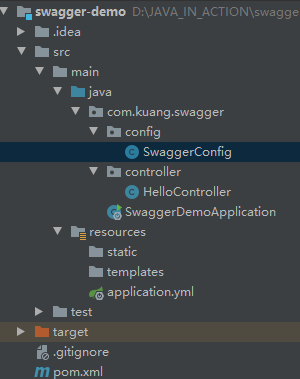
6.启动运行
http://localhost:8088/swagger-ui.html
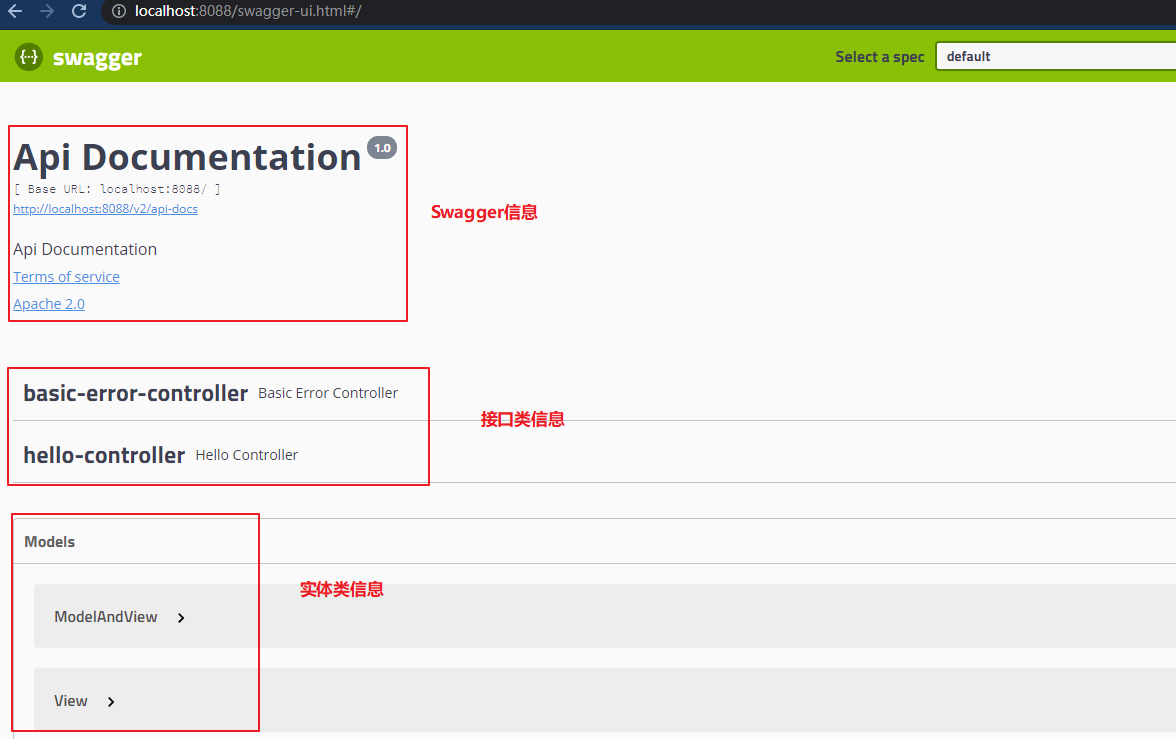
7.配置Swagger信息,即更改默认信息
在SwaggerConfig.java中配置
1 2 3 4 5 6 7 8 9 10 11 12 13 14 15 16 17 18 19 20 21 22 23 24 25 26 27 28 29 30 31 32 33 34 35 36 37 38 39 40 41 42 | /* * Copyright (c) Huawei Technologies Co., Ltd. 2021-2021. All rights reserved. */package com.kuang.swagger.config;import springfox.documentation.service.ApiInfo;import springfox.documentation.service.Contact;import springfox.documentation.spi.DocumentationType;import springfox.documentation.spring.web.plugins.Docket;import springfox.documentation.swagger2.annotations.EnableSwagger2;import org.springframework.context.annotation.Bean;import org.springframework.context.annotation.Configuration;import java.util.ArrayList;@Configuration@EnableSwagger2 // 开启swagger2public class SwaggerConfig { // 配置了swagger的Docket的bean实例 @Bean public Docket docket() { return new Docket(DocumentationType.SWAGGER_2).apiInfo(apiInfo()); } // 配置swagger信息=apiInfo private ApiInfo apiInfo() { // 作者信息 Contact contact = new Contact("gump yan", "https://www.cnblogs.com/GumpYan/", "5758878@qq.com"); return new ApiInfo( "gump yan的SwaggerAPI文档", "Api Documentation", "1.0", "https://www.cnblogs.com/GumpYan/", contact, "Apache 2.0", "http://www.apache.org/licenses/LICENSE-2.0", new ArrayList()); }} |

8.配置扫描接口
1 2 3 4 5 6 7 8 9 10 11 12 13 14 15 16 | // 配置了swagger的Docket的bean实例@Beanpublic Docket docket() { return new Docket(DocumentationType.SWAGGER_2) .apiInfo(apiInfo()) .select() // RequestHandlerSelectors 配置要扫描接口的方式 // basePackage():指定要扫描的包 // any():扫描全部 // none():不扫描 // withClassAnnotation:扫描类上的注解 .apis(RequestHandlerSelectors.basePackage("com.kuang.swagger.controller")) // paths() 过滤什么路径 .paths(PathSelectors.ant("/kuang/**")) .build();} |
主要为了扫描接口

这样配之后,之前的base-error-controller就不在了,就是指定包路径和请求路径
9.配置swagger启动
关闭swagger,用enable(false);enable(true)是开启,代码上线时候,正式发布的时候,注意关闭swagger


10.配置API分组
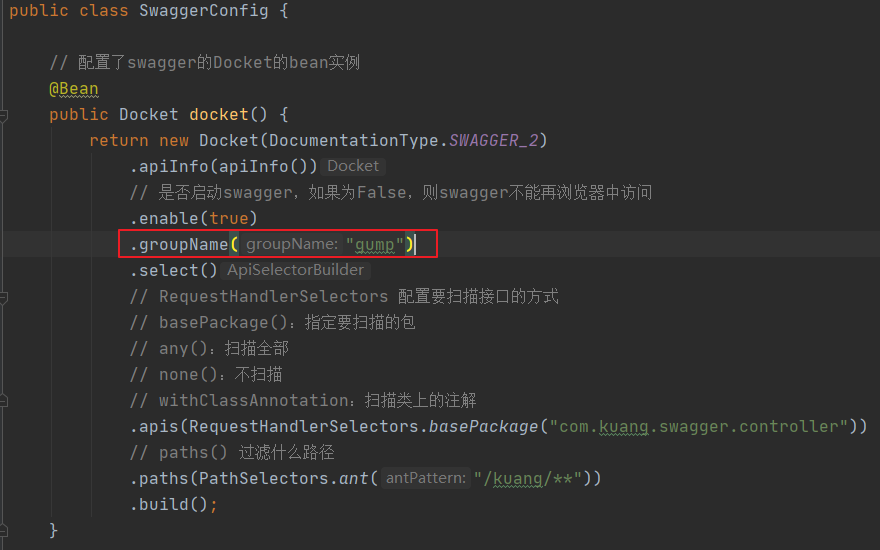

如何配置多个分组:多个Docket实例即可
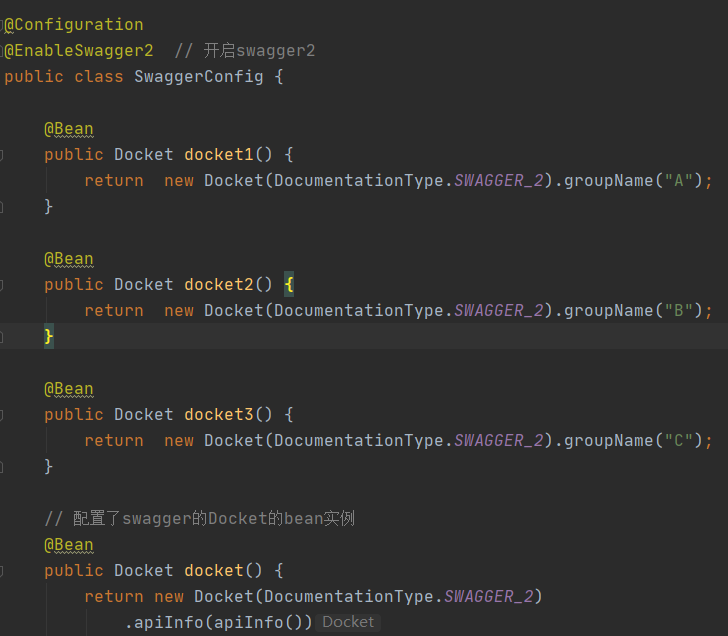
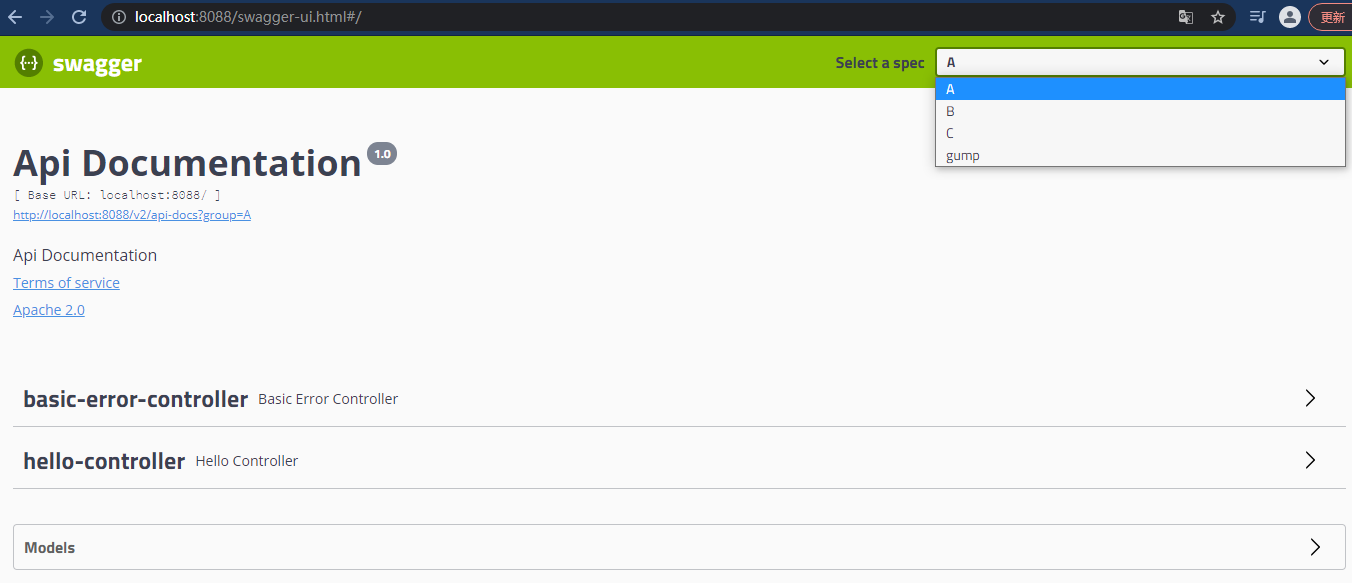
1 2 3 4 5 6 7 8 9 10 11 12 13 14 15 16 17 18 19 20 21 22 23 24 25 26 27 28 29 30 31 32 33 34 35 36 37 38 39 40 41 42 43 44 45 46 47 48 49 50 51 52 53 54 55 56 57 58 59 60 61 62 63 64 65 66 67 68 69 | package com.kuang.swagger.config;import springfox.documentation.builders.PathSelectors;import springfox.documentation.builders.RequestHandlerSelectors;import springfox.documentation.service.ApiInfo;import springfox.documentation.service.Contact;import springfox.documentation.spi.DocumentationType;import springfox.documentation.spring.web.plugins.Docket;import springfox.documentation.swagger2.annotations.EnableSwagger2;import org.springframework.context.annotation.Bean;import org.springframework.context.annotation.Configuration;import java.util.ArrayList;@Configuration@EnableSwagger2 // 开启swagger2public class SwaggerConfig { @Bean public Docket docket1() { return new Docket(DocumentationType.SWAGGER_2).groupName("A"); } @Bean public Docket docket2() { return new Docket(DocumentationType.SWAGGER_2).groupName("B"); } @Bean public Docket docket3() { return new Docket(DocumentationType.SWAGGER_2).groupName("C"); } // 配置了swagger的Docket的bean实例 @Bean public Docket docket() { return new Docket(DocumentationType.SWAGGER_2) .apiInfo(apiInfo()) // 是否启动swagger,如果为False,则swagger不能再浏览器中访问 .enable(true) .groupName("gump") .select() // RequestHandlerSelectors 配置要扫描接口的方式 // basePackage():指定要扫描的包 // any():扫描全部 // none():不扫描 // withClassAnnotation:扫描类上的注解 .apis(RequestHandlerSelectors.basePackage("com.kuang.swagger.controller")) // paths() 过滤什么路径 .paths(PathSelectors.ant("/kuang/**")) .build(); } // 配置swagger信息=apiInfo private ApiInfo apiInfo() { // 作者信息 Contact contact = new Contact("gump yan", "https://www.cnblogs.com/GumpYan/", "5758878@qq.com"); return new ApiInfo( "gump yan的SwaggerAPI文档", "Api Documentation", "1.0", "https://www.cnblogs.com/GumpYan/", contact, "Apache 2.0", "http://www.apache.org/licenses/LICENSE-2.0", new ArrayList()); }} |
11.接口注释
创建一个实体类User,加上swagger的注释
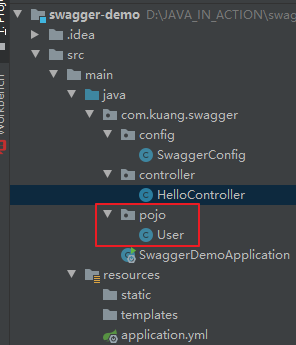
1 2 3 4 5 6 7 8 9 10 11 12 | package com.kuang.swagger.pojo;import io.swagger.annotations.ApiModel;import io.swagger.annotations.ApiModelProperty;@ApiModel("用户实体类")public class User { @ApiModelProperty("用户名") public String username; @ApiModelProperty("密码") public String password;} |


不仅可以看到注释,也可以在这里面做测试,这就是swagger的另一个好处,可以做postman的事情

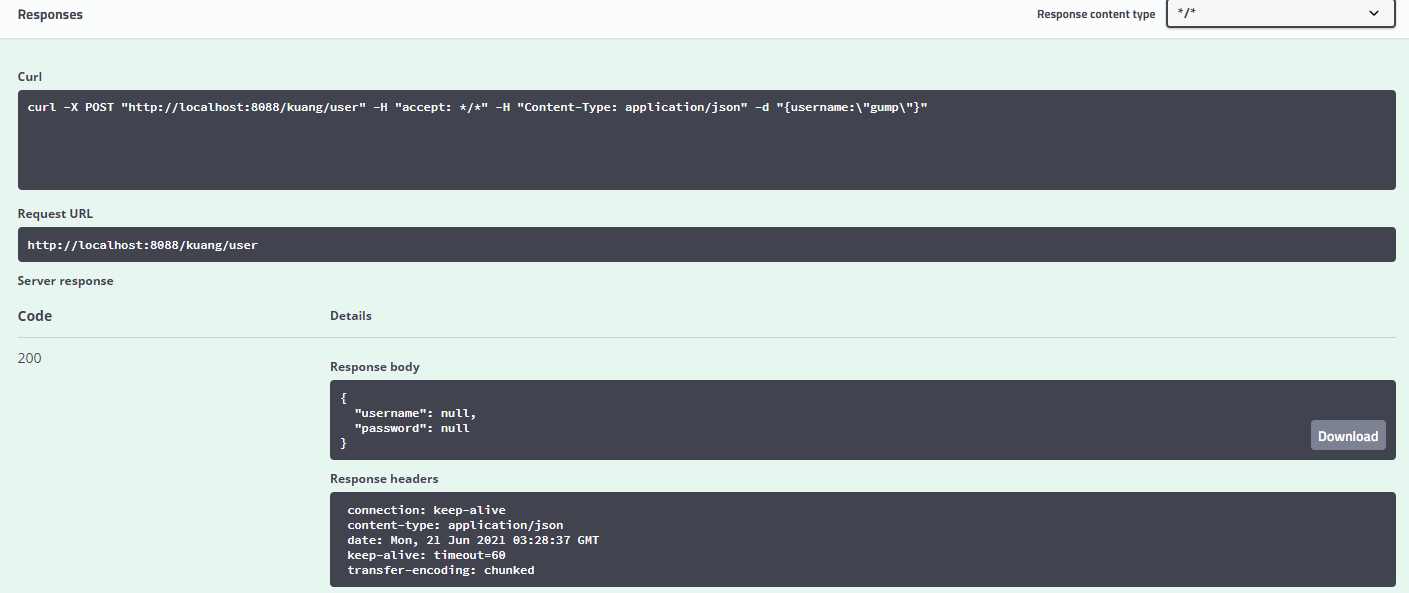





【推荐】国内首个AI IDE,深度理解中文开发场景,立即下载体验Trae
【推荐】编程新体验,更懂你的AI,立即体验豆包MarsCode编程助手
【推荐】抖音旗下AI助手豆包,你的智能百科全书,全免费不限次数
【推荐】轻量又高性能的 SSH 工具 IShell:AI 加持,快人一步
· 10年+ .NET Coder 心语,封装的思维:从隐藏、稳定开始理解其本质意义
· .NET Core 中如何实现缓存的预热?
· 从 HTTP 原因短语缺失研究 HTTP/2 和 HTTP/3 的设计差异
· AI与.NET技术实操系列:向量存储与相似性搜索在 .NET 中的实现
· 基于Microsoft.Extensions.AI核心库实现RAG应用
· 10年+ .NET Coder 心语 ── 封装的思维:从隐藏、稳定开始理解其本质意义
· 地球OL攻略 —— 某应届生求职总结
· 提示词工程——AI应用必不可少的技术
· Open-Sora 2.0 重磅开源!
· 周边上新:园子的第一款马克杯温暖上架
2020-06-18 BFS(找最短距离,最短路径)二叉树最小深度&打开转盘锁&对称二叉树
2020-06-18 python操作es增删改查
2020-06-18 最大子序和(动态规划)